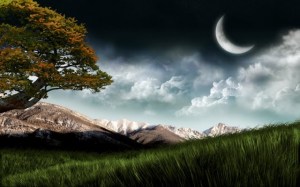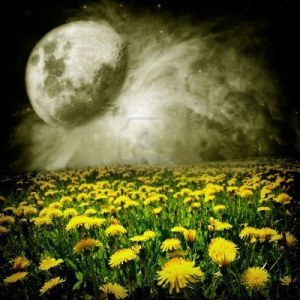It is not only the sun that determines the best time to plant a garden, but also our closest celestial neighbor, the moon. For thousands of years wise men and women have gardened in tune with the moon. Consider the difference in light under a full moon versus when the moon is dark, and how the moon creates Earth’s tides, and you will have an idea of the value of gardening with Luna.
 Plants and the human body consist largely of water; though the pull is subtle, we are as affected by the moon’s gravity as the oceans.
Plants and the human body consist largely of water; though the pull is subtle, we are as affected by the moon’s gravity as the oceans.
Gardening with the moon depends on two rhythms: light and gravity, determined by her journey around Earth.
To plant with the phases of the moon, note if your seeds are short, long, or extra-long germinating. Plant information on the back of seed packs includes how long it will take the seeds to germinate. Short-germinating seeds, like beans and lettuce, will germinate in one to seven days. Long germination means eight to twenty-one days and includes celery and garlic. Some plants take up to twenty-eight days to germinate, known as extra-long germinating seeds.
You want to put seeds in the Earth, or germinate them indoors so that they will germinate near the new moon, when the moon’s earthward pull is strongest. This pull helps the plant establish strong root growth.
 According to the biodynamic method of farming, short- and extra-long germinating seeds should be planted from two days before to seven days after the new moon. Long-germinating seeds and seedlings should be planted or transplanted at the full moon and up to seven days after the full. These planting times take advantage of gravitational and magnetic pull of the moon as well as levels of moonlight and give the seeds the optimum situation for their germination.
According to the biodynamic method of farming, short- and extra-long germinating seeds should be planted from two days before to seven days after the new moon. Long-germinating seeds and seedlings should be planted or transplanted at the full moon and up to seven days after the full. These planting times take advantage of gravitational and magnetic pull of the moon as well as levels of moonlight and give the seeds the optimum situation for their germination.
Other gardening activities can be attuned to the moon as well. At the new moon, prune to encourage growth. During the full moon, harvest herbs used for magic or healing, and pick fruits and vegetables for enhanced flavor. The waning moon is a time of settling and letting go; use this crone time as the moon’s energy settles back into the Earth to harvest root vegetables, weed, and prune to inhibit growth. During the dark of the moon, when lunar energy is deep in the Earth, take time to renew and be still.
This article was adapted from Sacred Land by Clea Danaan
All Images from Google.com




